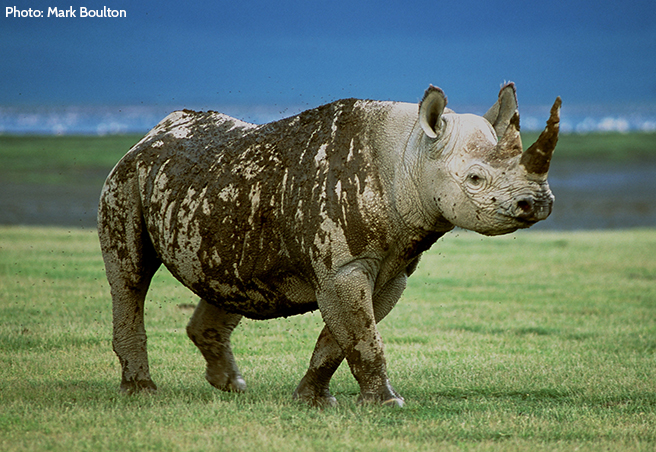Why Does It Matter if a Species Becomes Extinct?

The “butterfly effect”—the idea that a butterfly flapping its wings can set in motion a series of events that result in massive change halfway around the world—is a pretty apt way to describe our increasingly global and connected world. We could also call this the rhino effect.
In the United States or China, the imminent disappearance of the African black rhino may not appear to have much impact at first blush, but like the wind generated from a butterfly’s wings, losing the black rhino can have a global effect on everything from local ecosystems and economies to international politics and global markets.
Close to Home
Perhaps the most obvious impact the loss of the black rhino will have is its effect on nature. Functioning ecosystems are carefully balanced such that species keep each other in check. While populations may ebb and flow as conditions change, in the scheme of history the alterations are small.
Removing an entire species can dramatically change this calculus. In the American West, many scientists link the extermination of wolves to a spike in the elk population, their main prey. This has cascading effects: More elk means more pressure on aspen trees and their other food sources. Fewer elk being killed by predators means fewer carcasses for scavenging species. While nature is often too complicated to draw direct links, it’s clear that change begets change, and species and ecosystems that cannot adapt suffer.
These ecosystem changes have a real human cost as well. Black rhinos live exclusively in South Africa, Kenya, Namibia and Zimbabwe. Tourism is a significant contributor to the economies of all these countries. In South Africa—the lowest of the four—it accounts for nearly 10 percent. In Namibia on the other end of the spectrum, tourism comprises almost 15 percent of its GDP. Tourism directly supports nearly 1 million jobs in these four countries. Indirectly, the industry supports double that, including 19 percent of all jobs in Namibia, according to data from the World Travel and Tourism Council.
Large fauna, including the black rhino, are a primary draw for the millions of tourists that visit these countries. Losing these animals could stem the flow of tourists, not only putting existing jobs at risk, but also potentially leaving these workers with less environmentally friendly job options. In 2014, the Financial Times asked if Namibia was “Africa’s next big oil frontier” after new offshore deposits were found and oil companies began exploration. Yet, for Africa’s big game animals, the insidious, but long-time-horizon, effects of climate change are the least of their worries. Without reliable tourism jobs, some people turn to poaching, a dangerous but lucrative way to support their families.
Global Effects
Just as the fate of the black rhino affects the world, the rhinos themselves are not insulated from people who may never set foot in their current or historic habitat. Rhino horn is a purportedly powerful ingredient in traditional medicine from Malaysia to South Korea. Traditional Chinese medicine credits rhino horns with curing fevers and improving function.
International efforts to reduce demand for rhino horn and curb poaching have worked to a degree in China, where the ingredient was removed from the oeuvre of traditional medicine. Today, some of the largest demand for rhino horns comes from Vietnam, where it was rumored to have cured a politician of cancer in the 2000s. This rumor drove demand so high that in 2013, at $300,000 per horn, rhino horn was literally worth more than its weight in gold. Basic supply and demand tells us that the fewer rhinos there are, the higher the price will go until they’re poached into extinction.
Technically, international trade in rhino horns was banned in 1977 under the Convention on the International Trade in Endangered Species. But the black market for rhino horns has flourished. This has prompted calls to lift the ban and find ways to simply regulate trade instead. In 2012, two large rhino breeders sued the South African government arguing that, since rhino poaching has increased under the country’s moratorium on rhino trade, it should be lifted.
Enforcing the ban is difficult and expensive. In 2014, South Africa spent an additional $7 million to increase security at its national parks, but poaching continued. President Obama issued an executive order aimed at combatting illegal wildlife trafficking and, in 2015, released its implementation plan. But even before these added duties, U.S. post inspectors already admitted their inability to keep up with the illegal trade. To do so would require more manpower—and a lot more tax dollars to fund it.
While it’s clear we have serious challenges to protect the black rhinos we have left, what we don’t have is much time. The International Union for the Conservation Nature’s (IUCN) most recent black rhino count in 2013 found just 5,055 left. Compare that to the astounding 2,400 that were poached in the seven years prior. The scariest part is that the rate is increasing. IUCN estimated that in 2013 a rhino was killed every 11 hours. That leaves two choices: Either humans commit to serious action to protect black rhinos, or we start preparing for a world with fewer rhinos, fewer tourism jobs, higher demand for rare horns and a lot more impacts we can’t imagine yet.
